Here are some astonishing figures:
- According to Bloomberg, 8 out of 10 entrepreneurs who start businesses fail within the first 18 months.
- Only 50% of businesses with employees survive their fifth year in business.
- Of the companies on the Fortune 500 list in 1955, only 12% remain. The rest either went bankrupt, merged, acquired or fell off the list.
This looks bleak. Businesses today are not able to survive the pace of change.
Whole industries are getting disrupted, and it’s impossible to predict what’s coming.
Yet, there are some compelling reasons why there’s never been a better time to start a business.
- Accessible funding. You no longer have to wait in long lines to raise funding. Services like Kickstarter and Crowdfunder allow you to get the capital you need to fund your idea.
- Lower costs. Cheaper and better technology has lowered the barrier to entry, speeding distribution channels and reducing overheads.
- Attract global talent. It’s easier now, thanks to the Internet, to establish & maintain a global workforce. You can attract talent at more affordable costs.
- New opportunities opening up. As the population grows, people’s interests and preferences are fragmenting. This is giving rise to several untapped niches available for entrepreneurs to fill.
As a business owner, I’m always searching for ways to help my organization thrive and at the same time protect it from the threats of a rapidly changing world.
I’ve found the key lies in understanding the role of power in today’s world.
The Decay of Power and What It Means For Your Organization
Power is shifting.
Smaller, more innovative players are displacing the more traditional powerhouses of the global economy. We’ve seen in front of our eyes how:
- Amazon has replaced bookstores and other retailers
- Netflix has taken over Blockbuster
- Uber is killing taxi companies
- Airbnb is now the largest provider of travel accommodations
There are many such examples of power-shifts. However that’s the not full story. Power is not just shifting from one company to another.
Power is decaying.
Moises Naim observed in his book, The End of Power the three trends that are eroding the barriers to holding power:
- The “more revolution” — there are more of us, and we have more resources — overwhelms power.
- The “mobility revolution” circumvents power by moving people and information further and faster.
- And the “mentality revolution” undermines it by making people less deferential.
As the barriers that keep power in place are eroding, those who have power find it difficult to use and easy to lose.

“The decay of power is an exhilarating trend in the sense that it has made space for new ventures, new companies and all over the world, new voices and more opportunities. But its consequences for stability are fraught with danger.” ~ Moises Naim
Here are some ways the decay of power can impact your organization:
- Without being able to adapt to changing times, new startups and competitors that are entering the market ready to displace you.
- With an increasing number of options available, your customer’s taste’s and preferences have become more nuanced. Unless you’re able to cater to it, they’ll move to other options.
- Millennials form the largest generational workforce. They want more power in the form of freedom and autonomy in their work. Unless your organization has a system to distribute power effectively, it’ll be difficult to retain your most talented team members.
Without the ability to effectively manage and organize power, the organization’s stability, and it’s ability to get work done, decreases.
Current Structures Make it Difficult to Get Things Done
If we plot the decay of power on the x-axis and stability on the y-axis, this is how it would look like:
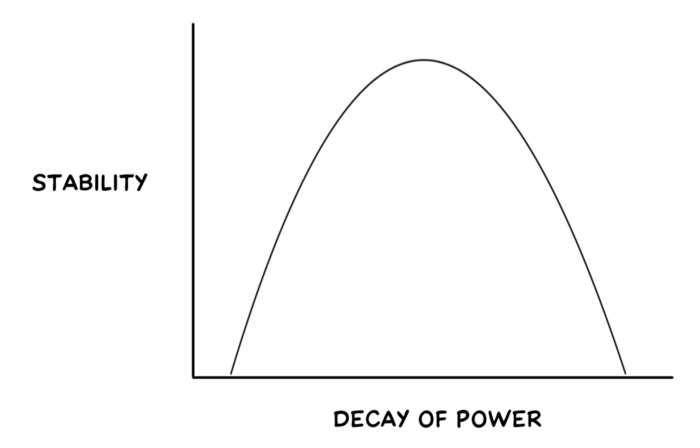
On the extreme left power is concentrated. Organizations here have a command and control system to manage power.
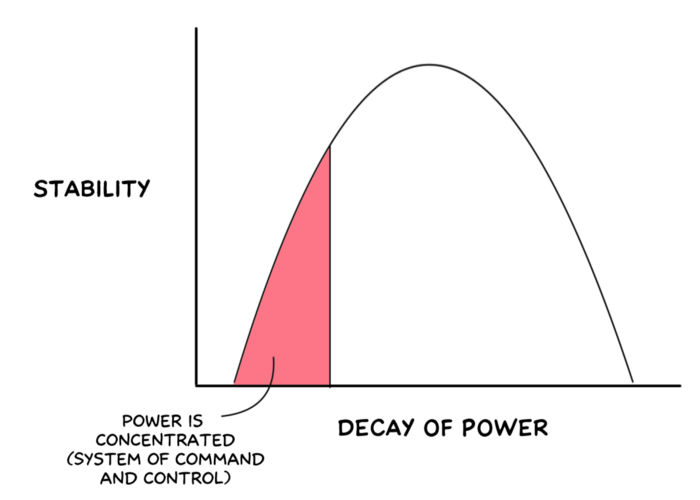
Have you ever been in organizations where you need to get everyone’s “buy-in” to get anything done? This is what happens when power decays to the right.
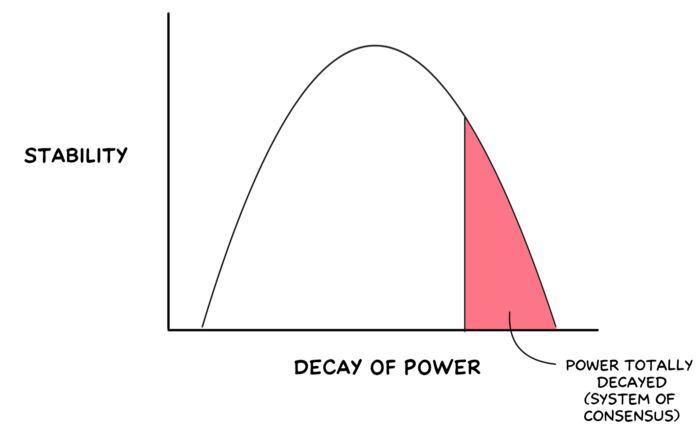
Here power has decayed to such an extent that the organization has become paralyzed. It’s complicated to move forward because everything requires the consent of other members.
In the absence of an effective system to manage power, as power decays in an organization it becomes a system of Vetocracy.
“A vetocracy refers to a dysfunctional system of governance whereby no single entity can acquire enough power to make decisions and take effective charge.”
Even though it may seem like a nice to get everyone’s agreement before moving forward, in practice, it paralyzes the members to make critical decisions to move the organization forward.
Holacracy — A New Social Technology To Organize Power in Pursuit of Purpose
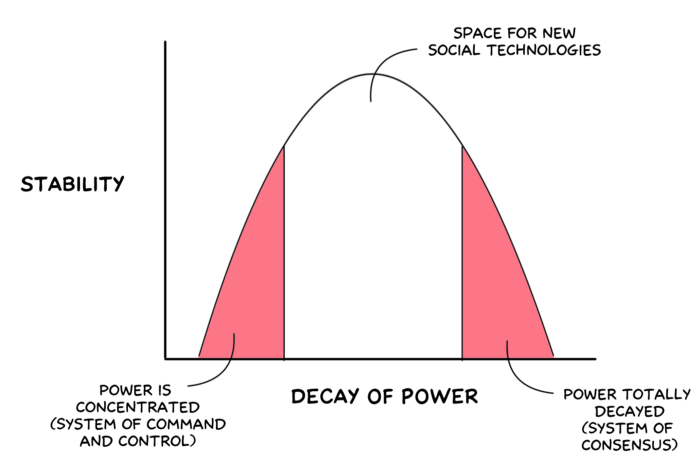
“You never change things by fighting the existing reality. To change something, build a new model that makes the existing model obsolete.” ~ Richard Buckminster Fuller
Frederic Laloux documents in this book, Reinventing Organizations a new generation of organizations characterized by self-organization, evolutionary purpose, and wholeness. He calls them “teal” organizations.
They’re at the cutting edge of what the future of organizations are going to be like, and demonstrate new ways of managing power in an organization.
But if you want to implement them in your organization, they’re very difficult to replicate, because their respective systems evolved out of their unique cultures.
However, there was one exception in Laloux’s book, HolacracyOne. It runs on an “installable” self-management system called Holacracy. Tom Thomison, co-founder of HolacracyOne, defined it as:
“Holacracy is a complete wholesale replacement of the Management Hierarchy. It’s exploring work in pursuit of purpose.”
Holacracy is a new social technology that any organization can adopt to self-organize. Instead of people holding power, the power lies with the constitution which has a set of rules on how to distribute authority to roles in the organization.
As I adopted Holacracy in my organizations, I experienced a new way of managing power other than the command and control, top-down hierarchical way.
Here I’ll share with you five ways Holacracy organizes power, and how it can help meet the demands of a rapidly changing world.
5 Ways Holacracy Organizes Power to Thrive in a Rapidly Changing World
1. Meet Your New Boss — Purpose
An organization running under the Management Hierarchy, also has a purpose, but you don’t have the freedom to express it directly.
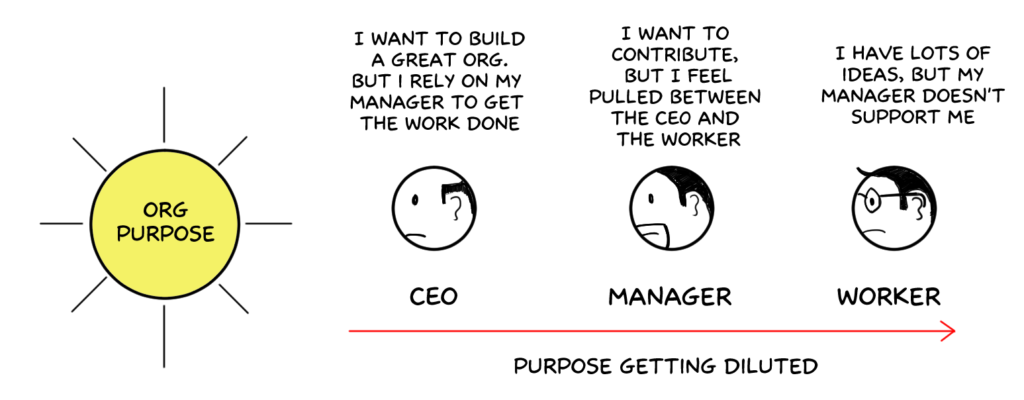
You have a manager, who has a boss and maybe another boss. And unless you all see eye to eye, you won’t have the freedom to fully express your purpose.
In a Management Hierarchy the purpose of the organization gets diluted and filtered through the levels of authority.
In Holacracy, a direct purpose-to-purpose relationship runs through the organization. People pursue work that aligns with their purpose.

There’s no central authority or managers. You don’t have people managing people. You have purpose agents who self-organize under the Holacracy constitution and engage in the work of the organization.
2. Yup. You’re the Leader. You Lead Your Role(s).
You may be wondering, are there any leaders in an organization without a hierarchy?
Yes. Everyone’s a leader, but it’s a different kind of leadership. In Management Hierarchy Leaders lead people. In Holacracy, people lead “roles”.


Each role has a clear purpose and accountabilities expected of them. Once a person energizes a role, the constitution grants them full authority to do what is necessary to fulfill the purpose of their role(s).
For example, if you’re in a role called Web Designer that has the accountability of updating the website with the product details, you don’t need permission to make updates. You don’t have to have long meetings to get everyone’s buy-in. As long as you work within the bounds of the constitution, you have full authority to get the work done.
In that sense, you lead your role.
“It (Holacracy) is a system where everyone has autocratic authority but they know the bounds of that authority. They know the interconnections, they know when they have to get someone else’s input. They know what they can expect of each other.” — Brian Robertson
No more single heroic leader that everyone looks to for answers. In Holacarcy, everyone is a hero, called upon to lead their roles.
3. It’s not Hierarchical or Flat. It’s Holarchic.
Because Holacracy is a replacement of the Management Hierarchy, it’s often confused with being a flat organization, without a structure.
In fact, Holacracy is often more structured than a Management Hierarchy. But it’s not a structure of people, it’s a structure of roles.

Think of a human body. Each cell function autonomously within organs, which in turn function autonomously within the body. There’s no CEO cell that tells other cells what to do.
Similarly in Holacracy power is held by roles, not people, and those roles gain power through a governance process, not from a boss delegating it. Each role is autonomous with a clear boundary and purpose.
What emerges is a lot of clarity and freedom for people to use the power within their roles to get work done.
4. In a Conflict? There’s no Manager to go to. Use the Process to channel your tension.
As you rise up the ranks of a Management Hierarchy, you’ll soon realize that a lot of your energy goes into managing people and not doing work that directly adds value to your customer.

That’s because it’s the role of the manager to create alignment, especially when there’s a conflict.
But how do you resolve conflicts in an organization without managers?
For that, you need a process. A process that aligns and integrates. In Holacracy, anyone can use the governance process defined by the constitution to remove what is in the way of their Role’s work.

It removes the need to have managers, and lets each person be autonomous.
There’s very little room to be a victim. Do you have a problem? You don’t need a manager to take care of you. You can use the process to take care of your role’s work.
“Get the ongoing process right, and it will keep generating ongoing benefits. In our new era, processes trump products.” Kevin Kelly
This frees up energy which people can use in their work.
5. A Responsive Conscious Organization
How does an organization adapt to changing times?
A Management Hierarchy is a rigid structure that is designed upfront to address a certain need. So the only way to adapt is to go through re-organizations that are painful, disorienting and expensive.

Holacracy allows for incremental changes. Any tension sensed by anyone in the organization has some place to go to get rapidly and reliably processed into meaningful change.
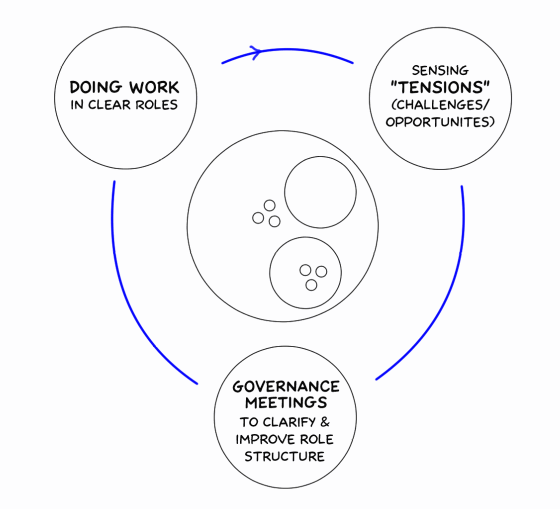
These changes result in small changes to the structure, just enough to meet the demand.
“We process that tension to change the design, we express that design, and we test it and start the cycle over again. This is how Holacracy introduces the innovation of evolution inside our companies.” ~ Brian Robertson
Instead of a master architect applying a perfect structure up front, Holacracy uses the power of evolutionary process to meet the demand of changing times.
Power is Decaying. Is Your Organization Ready?
“Power is changing in so many areas that it will be impossible to avoid important transformations in the way humanity organizes itself to make the decisions it needs to survive and progress.” ~ Moises Naim
The forces at play are accelerating the decay of power. And not doing anything threatens the existence of our organizations. You do not want to be in the 8 out of 10 entrepreneurs who fail in the first 18 months.
The reinvention of work is no longer a choice.
But we don’t have to be carried away by these forces. By adopting new social technologies, our organization can not only survive, but thrive.
Getting Started with Holacracy
Here are some resources to get started with Holacracy
Holacracy.org Official website. Check out their Tactical & Governance Meeting Formats.
Follow me on Twitter for more insights on productivity, GTD, and self-management.
I believe our work should be an expression of our most creative selves. I work with business owners and their teams to achieve stress-free productivity.

